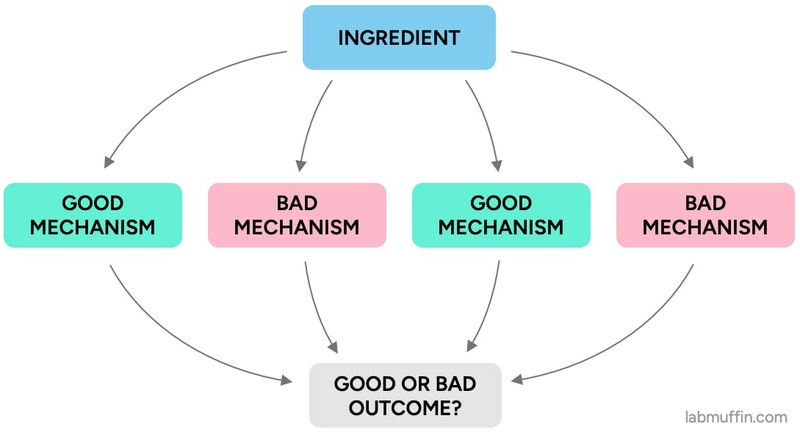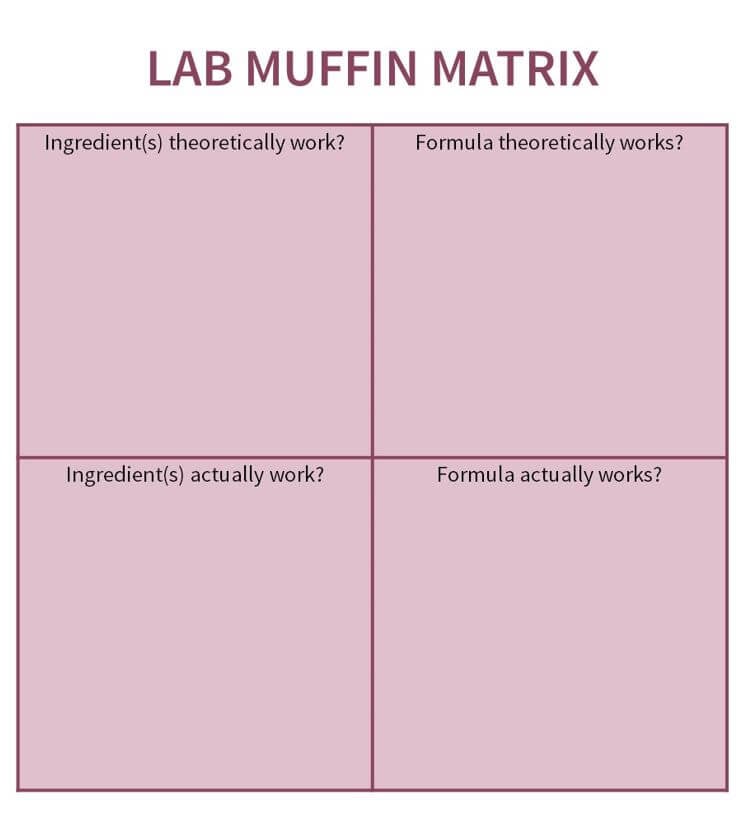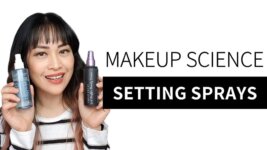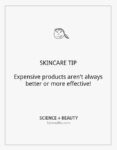There’s a troubling pattern with a lot of “science-based” cosmetic products. Many of them make claims solely based on mechanistic reasoning, rather than any actual measured effects on humans.
This is a big problem because mechanistic reasoning often doesn’t predict what happens on actual humans – and it’s especially the case with the ways these claims are often used for cosmetic products.
It’s a complex topic, but hopefully this article will give you more insights!
What is mechanistic reasoning?
Mechanistic reasoning refers to microscopic effects of ingredients and products. Some examples:
- Rosemary oil is spasmolytic, so it enhances blood flow and leads to reduced hair loss
- Antioxidants neutralise free radicals that can damage skin components like collagen and elastin, so they prevent wrinkles
- Tranexamic acid inhibits urokinase-type plasminogen activator, so it reduces pigmentation
These mechanisms of action are discovered through a wide range of scientific experiments – usually ones that don’t involve humans. For example, they might involve seeing how an ingredient interacts with cells, enzymes, isolated skin samples, or genetically modified rodents.
Now don’t get me wrong: mechanisms of action are incredibly interesting, and useful to know. But on their own, they aren’t actually good evidence for whether an ingredient works. And unfortunately, because they tend to sound “sciencey”, it inflates the credibility of brands and content creators don’t actually have a good understanding of cosmetic science.
Related post: Scientism or “Science-Washing” in Beauty
Understanding mechanistic reasoning
The problem with relying on mechanistic reasoning: there are a lot of mechanisms happening inside your body, and they can have completely opposite effects.
This means you can usually come up with mechanistic reasons why an ingredient could cause both good and bad outcomes.

An analogy: it’s like predicting whether your friend Brian will be early or late to lunch. You can come up with lots of reasons for why he might be early:
- he doesn’t live far away
- he likes to wake up early
- he has a car and he’s a good driver
- he’s a hungry dude
You can also come up with lots of reasons why he might be late:
- he has a busy job
- it’s hard to get parking near the cafe
- it’s raining
- there’s a bit of traffic
Some of these reasons are more convincing than others. Sometimes the reasons are so convincing you pretty much know – like if Brian posted an Instagram story of his flat tyre 2 minutes before you were meant to meet.
But taking into account all of the variables that can affect each reason is hugely complicated. For example, just for rain:
- How much rain is there at each part of his journey?
- Is the level of rain consistent or changing?
- Has there been rain on previous days that’s led to more likely flooding?
- Are the drains on the way to the cafe well-maintained?
- Are his windscreen wipers working well?
- Are the windscreen wipers of the other drivers on the road today working well?
So most of the time, these reasons are nowhere near as reliable as checking past examples of the same outcome: Is he usually early or late when you meet up?
And the closer the past examples are to your current situation, the better your guess will be. Is he usually early or late when you’ve met up at this cafe for lunch before, when it’s raining and there’s a bit of traffic?
Why mechanistic reasoning fails
It’s the same for drug and cosmetic ingredients. The sum total of any mechanisms determines the final outcome. Which reasons outweigh others?
And weighing up these mechanisms is usually no small task, even with modern computational methods.
For example, these mechanisms often happen at different physical locations in the body. Consider a skincare product: it might have potential mechanisms at different depths in the skin.
- How much of the ingredient actually reaches each of these places where the mechanism takes place?
- Is it enough to translate into an observable impact?
- Is there another mechanism in the skin that undoes that effect? (e.g. does the skin respond to inhibition of a particular enzyme by producing more of it?)
This is even before we take into account formulation:
- Is ingredient penetration affected by the formulation?
- Is the ingredient stable enough in the specific formula and packaging?
And just like with Brian and lunch, usually the most reliable way we have of weighing up the mechanisms and predicting the outcome is looking at past examples. Was there a noticeable difference when the treatment was tested on actual people?
That’s why experiments like clinical trials are so useful, and why “actually works” is important in the Lab Muffin Matrix (I talked about it here).
Related post: Ultimate Vitamin C Skincare Guide Part 1: Ascorbic Acid

How often does mechanistic reasoning fail?
There’s actually a lot of hard data on how poor a predictor of outcomes mechanistic evidence is – in drug discovery.
My PhD was in medicinal chemistry, which is near the start of the drug discovery pipeline. We would usually start with promising ingredients (lead compounds) that have good mechanistic evidence, then put them through more testing, in the hopes that they’d turn out to be useful medications.
Even with good mechanistic evidence, only about one in 10,000 compounds that would end up as a successful drug.
And the main issue was usually lack of clinical efficacy – according to this analysis of 218 drugs that failed Phase 2 and 3 clinical trials from 2013 to 2015, 52% failed for this reason. In other words, things with promising mechanisms usually don’t work well in people. And these drug candidates usually had a much higher level of mechanistic evidence and convincing animal testing data than many cosmetic ingredients.
That’s why clinical trials are so important, and why approved drugs are more reliable – because to get approved as a drug, it actually worked in humans in robust clinical trials as well.
Are clinical trials the only answer?
That’s not to say that robust clinical trial evidence is the only type of reliable evidence that an ingredient works – other forms of evidence on actual humans like biopsy data can be convincing too, and there are many practical reasons why there’s so little publicly available high quality clinical trials on cosmetic ingredients.
For example, there’s a pretty overwhelming consensus that retinol works, thanks to a combination of human trials and convincing mechanistic reasoning.
Related post: Is Retinol a Scam? The Science
But this isn’t the case with many cosmetic ingredients. Chances are, an ingredient with almost no testing on actual humans is not worth trying – even if the mechanisms are full of impressive sounding jargon.
This article was adapted from part of this video, on whether rosemary oil works for hair loss.





